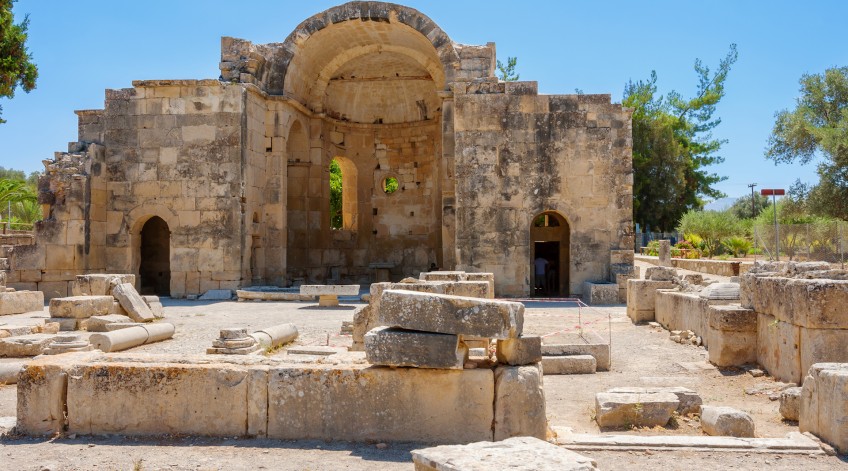ARCHAEOLOGICAL SITES
The archaeological site of Gortys
Situated 36 kilometres far from Agia Galini.
According to the archaeological evidence the area seems to have been inhabited as early as the end of the Neolithic period, approximately 3000 b.C. However, it is during the Late Minoan period (1660-1100 b.C.) that the site reaches its peak, as it is evidenced by the villa with the sanctuary excavated at the site of Kannia Mitropolis. The site continued to flourish in the Archaic period (7th century b.C.)and later, as it is shown both by the remains of the archaic settlement around the acropolis, and by the famous long inscription known as the "Gortyn Law Code", which dates back to the 5th century b.C.
During the Hellenistic period (3rd -2nd centuries b.C.) Gortyn(a) was still active; the Roman domination (1st-5th century A.D.) signals another peak period for the city, which was an close ally of the Romans and the capital city not only of the island, but also of the province of Cyrene in Africa. It was here that Apostle Titus, the protector of Crete, preached Christianity in 250 A.D. and Aghioi Deka ("the ten saints") died martyrs during the period of persecutions of Christians by the emperor Decius.
In 824 A.D., the city, which was then the seat of Archbishop, was destroyed by the Arabs. Excavations started in 1884 by Italian archaeologists and are still in progress. Along with the excavations restoration works, mainly of the ancient buildings, are being done throughout all this period of time. In what concerns the "Gortyn Law Code" it has been embodied in the Northern circular wall of the Odeon, which is now housed within a small recent structure for protection reasons.
The most importand monuments and architectural complexes the visitor can see at the site are:
The Odeon, a typical Roman theatre of the 1st century with two entrances facing the North and a semicircular orchestra, paved with white and grey marble. The northern wall of the stage, formerly raised, had four niches to house statues and was also paved with mud-bricks and marble. Only three rows of seats are preserved at the cavea ("koilon"). Below the Odeon, at a lower level, there was a circular structure of the Archaic Period. It is here that the stones inscribed with the "Gortyn Law Code" were walled in; when the Odeon was constructed the stones were transferred there.
The monument was destroyed by the Arabs in 824 A.D. and was discovered in 1884 when parts of the "Gortyn Law Code" came in light. Excavations of the Odeon were conducted from 1899 up to 1921. Today the Northern circular wall of the Odeon is housed within a small recent structure in order to protect the inscription.
The "Gortyn Law Code" is a long inscription containing a complete Legislation Code, dating back to the mid 5th century. Although the city was Doric in this period of time, the inscription echoes the Minoan law and customs, a fact that shows very clearly the power of the Minoan tradition which continued to exert its influence some 1000 years after the Minoan civilisation had collapsed.
A very interesting building is the Isieion, the sanctuary of the Aegyptian divinities, dated in the 1st-2nd centuries A.D. It is a rectangular space dedicated to various Aegyptian gods as Isis, Serapis-Zeus and Anubis-Hermes. The statues of the gods stood on an oblong podium with crepis, whereas the temple had also an underground cistern. The temple is very interesting as it clearly shows the influence of the Aegyptian religious tradition during the fist centuries of our era.
The Temple of Apollo Pythios was built in the Archaic Period (7th century b.C.). At this period of time it was a rectangular building with a treasury. Later on, during the Hellenistic and Roman times several features were added up to the original building, as the prodomos, the colonnades; the statue of Apollo Pythios stood in a niche.
Another important Roman building is the Praetorium, seat and residence of the proconsul of Crete. The building is divided in two sections: the administrative one, which has a central building, the "basilica", and theresidential, more private sector. The ruins preserved are dated to the 2nd century A.D., but there is also evidence of repairments dating to the 4th century A.D.
Next to the Praetorium, at the North, is situated the Northeast cistern and Nymphaeum. When built, it was a rectangular open cistern with niches on every side housing statues of Nymphes, from which the construction took its name; in the 7th century A.D, it was converted into a vaulted cistern.
The acropolis is found on the hill of Aghios Ioannis, overlooking the site. Parts of the fortification of the site going back to the 10th-6th century b.C. are well preserved. It is a polygonal fortification wall with towers at the angles. An archaic temple, on the ruins of which an Early Christian basilica was built are found within the fortified area.,
Finally, the church of St. Titus is a stone made cruciform church with three semicircular niches, three-sided at the external part and two small arches on the northern and the southern arm of the cross. The church undrerwent several changes and reconstructions; what we see today goes back to the 6th century A.D. The church was destroyed by the Arabs in 824.

